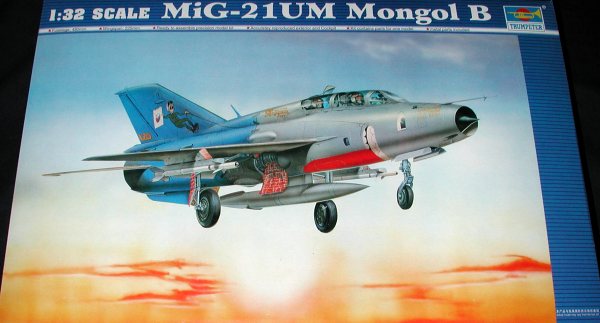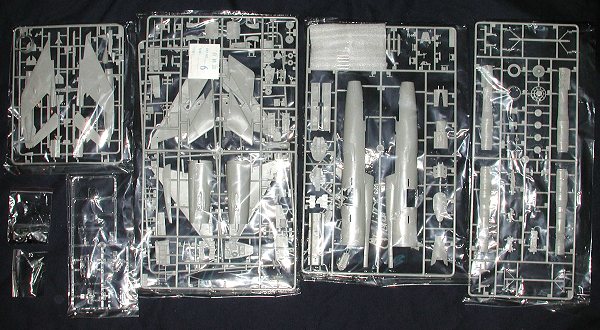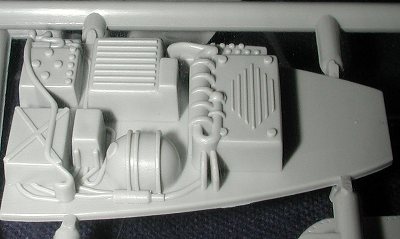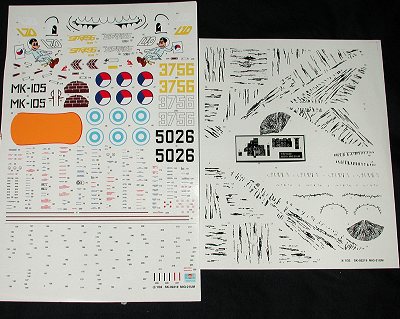
|
KIT: |
Trumpeter 1/32 Mig-21UM |
|
KIT # |
2219 |
|
PRICE: |
$55.00 |
|
DECALS: |
Three Aircraft |
|
REVIEW & |
|
|
NOTES: |
` |

|
HISTORY |
The Mig-21 is an aircraft that enthusiasts of my generation could easily identify. After the huge success of the Mig15/17, the 21 was an equal benchmark for the MiG Design Bureau. What was needed was basically a point defense interceptor. It would be able to get off the ground quickly to intercept incoming aircraft. Since low weight was the major factor in the design, there was little space given for fuel or heavy weapons systems. Since it was to be controlled from the ground, the only radar needed was one to assist the guidance of the twin AA-2 Atoll missiles that it carried. A gun was also added as early air to air missiles were not very good.
What you basically had was a fair weather day fighter with very little range. About 35-45 minutes of fuel was all that was carried as it would never be asked to do any long range missions. There were other aircraft for that. The plane was kept in production through at least three different generations and exported widely as they really were inexpensive compared to Western fighters. Many are still in active service as upgrades to equipment to increase capabilities are a lot less expensive than buying new planes.
|
THE KIT |

When Trumpeter brought out its early MiGs followed by the A-10 earlier this year, there were rumors of a Mig-21 on the horizon. Well, we now have this Mig-21, a two seat trainer. Undoubtedly there will be other variants to follow as I can easily foresee at least a PF and MF or bis version coming along. The sprues alone will attest to the kind of engineering done to let this happen.
 Anyway, I do have a soft spot for
two seaters and was made an offer I couldn't refuse on this kit (thanks, Steve)
so bought it. When one finally pries open the thick cardboard box, one is
presented with a myriad of bags full of sprues. Learning from the A-10 (whose
box I cannot get fully closed), I left the sprues in the bags, however, I was
able to get a good look at the parts. Frankly, I am quite impressed with the
level of detail. As you can see from the close-up of a single part, detailing is
good. Now I'm sure there will be people fussing about not having all that stuff
separate, but I'm glad it was done this way.
Anyway, I do have a soft spot for
two seaters and was made an offer I couldn't refuse on this kit (thanks, Steve)
so bought it. When one finally pries open the thick cardboard box, one is
presented with a myriad of bags full of sprues. Learning from the A-10 (whose
box I cannot get fully closed), I left the sprues in the bags, however, I was
able to get a good look at the parts. Frankly, I am quite impressed with the
level of detail. As you can see from the close-up of a single part, detailing is
good. Now I'm sure there will be people fussing about not having all that stuff
separate, but I'm glad it was done this way.
The kit includes such things as a full engine, a removable rear fuselage to show this engine, metal landing gear and rubber tires. I could do without the rubber tires as these things tend to split after a few years, but I'm sure some aftermarket wizard is right now making resin copies. A nice touch is that some of the more fragile parts are protected with extra foam padding.
 There are separate flaps, ailerons
and rudder, though pictures show that the flaps are always up unless undergoing
maintenance and the other control surfaces left in a neutral position. However
it is the thought that counts. Both underfuselage speed brakes can be displayed
deployed and the canopies can be positioned open. There is also a boarding
ladder and a stand for the rear fuselage when displaying the engine. Things
under wings consist of two Atoll missiles and a centerline fuel tank. The
detailing in the cockpit is superb with well done tubs and instrument panels.
Each seat consists of nine separate pieces and there is a pilot figure to go
along with it. One would have hoped for a second crew member since this is a
trainer, but there it is.
There are separate flaps, ailerons
and rudder, though pictures show that the flaps are always up unless undergoing
maintenance and the other control surfaces left in a neutral position. However
it is the thought that counts. Both underfuselage speed brakes can be displayed
deployed and the canopies can be positioned open. There is also a boarding
ladder and a stand for the rear fuselage when displaying the engine. Things
under wings consist of two Atoll missiles and a centerline fuel tank. The
detailing in the cockpit is superb with well done tubs and instrument panels.
Each seat consists of nine separate pieces and there is a pilot figure to go
along with it. One would have hoped for a second crew member since this is a
trainer, but there it is.
What is really impressive are the decal sheets. They are huge. There are more stencils than you can shake a stick at and the markings for the box art plane are incredible. This plane is used for test purposes and carries a very colorful paint scheme. All of the markings on the sheet to the right are used on the upper surfaces. They are supposed to show stress marks and buckling. There is simulated brick for inner wheel well doors, and the tail and nose markings are complete. What doesn't jive with the box art is the long orange 'tongue'. I think this is supposed to be red. You also get markings for a 'normal' Czech plane and a Finnish version. No doubt the decal makers are hard at work coming up with other markings for this plane, though the ones in the box will be difficult to beat.
The instructions are well done but the color callouts leave a lot to be desired. For instance, much of the interior is listed as being 'blue'. We all know that Migs have a very specific shade for cockpits. Other colors are similarly vague until you get to the overall scheme on the decal placement guide. There are then references to specific Gunze paints.
Overall, it looks like a really great kit and one that I may actually build. I have a weakness for modern aircraft in this scale, however, it seems that my 1/32 building averages out to about one every five years! Though I'm sure the pundits will find things wrong with it, the kit looks really good in the plastic and should be a relatively hassle-free build.
Review kit courtesy of me and my wallet!
If you would like your product reviewed fairly and quickly by a site that averages thousands of visits a day, please contact me or see other details in the Note to Contributors.